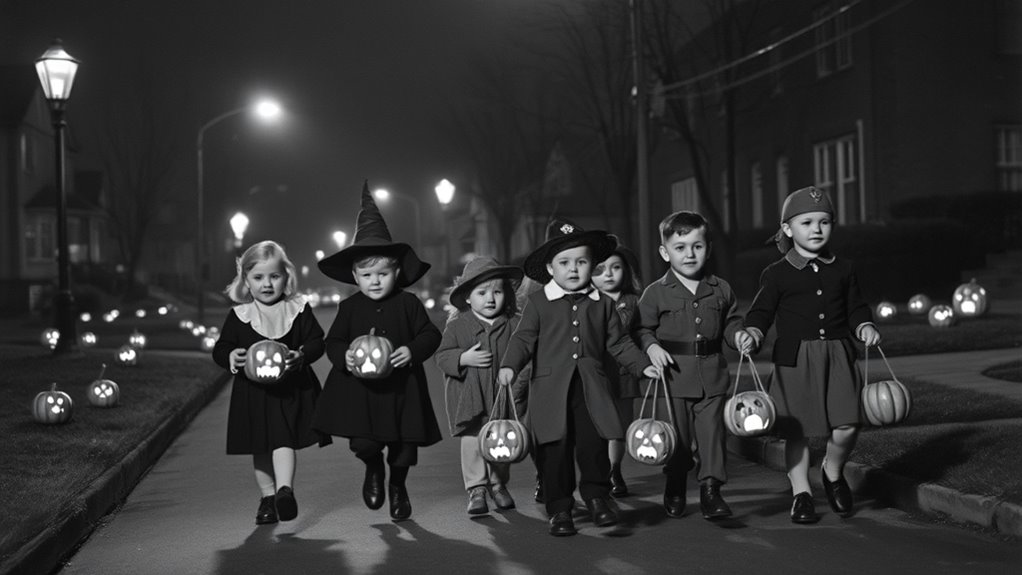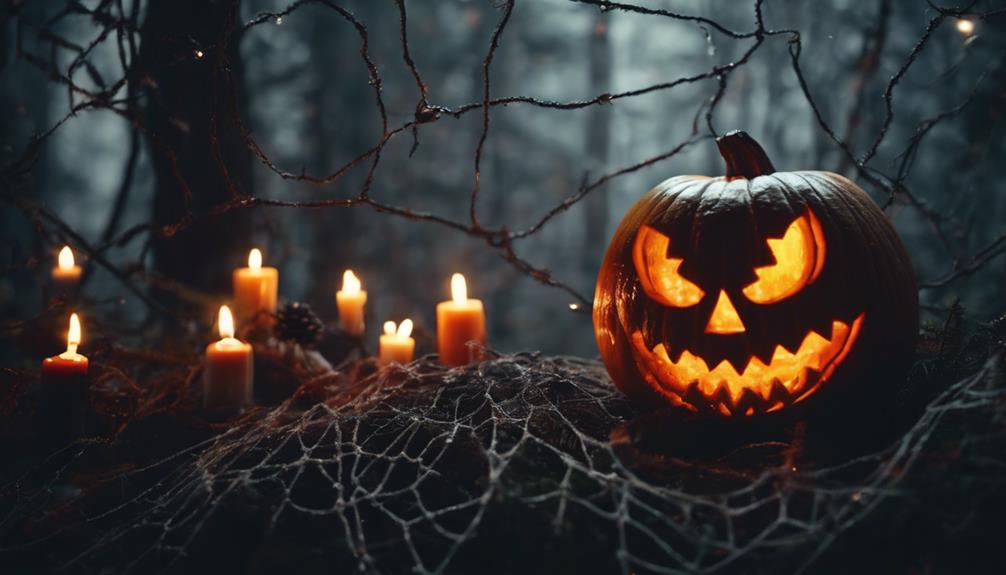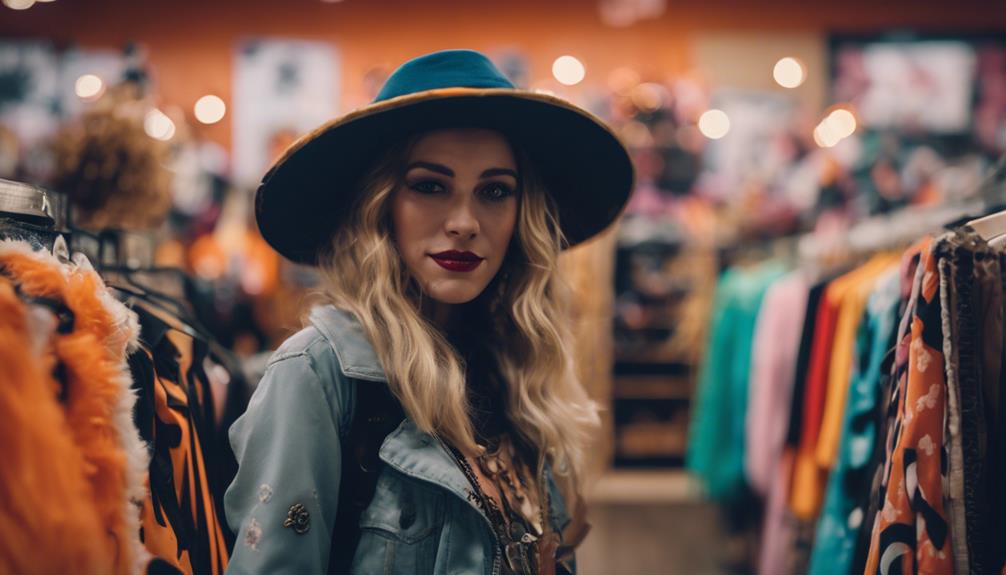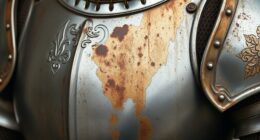During WWII, Halloween celebrations continued despite rationing and resource shortages by encouraging community creativity and resourcefulness. You and others made costumes from household items like fabric scraps, cardboard, and old clothes, turning everyday objects into spooky or fun outfits. Neighbors shared ideas and materials, fostering a sense of camaraderie. Celebrations focused more on imagination and tradition rather than extravagance, proving that resilience and inventiveness kept the holiday alive. If you keep exploring, you’ll discover even more about how communities adapted during that challenging time.
Key Takeaways
- Halloween celebrations persisted during WWII, with communities adapting parades, parties, and trick-or-treating to wartime restrictions.
- Costumes were creatively made from household items like old clothes, fabric scraps, and cardboard due to resource shortages.
- Neighbors shared ideas and materials, fostering community collaboration and emphasizing ingenuity over expense.
- Festivities were modified to conserve resources, avoid attention, and maintain traditions within wartime limitations.
- Halloween became a symbol of resilience, with creative adaptations highlighting community unity amid wartime hardships.

Have you ever wondered how Halloween celebrations persisted during one of the most challenging times in history? During World War II, the war effort drastically changed everyday life, yet Halloween remained a meaningful tradition for many communities. Facing shortages and rationing, people got creative with costume ingenuity, turning limited resources into clever, memorable disguises. Instead of store-bought costumes, children and adults alike repurposed old clothes, scraps of fabric, and household items to craft their outfits. A cardboard box transformed into a knight’s armor, a pillowcase became a ghostly shroud, and leftover paint or makeup created spooky faces. This resourcefulness not only kept the spirit of Halloween alive but also fostered a sense of pride and achievement among participants. Your neighbors, friends, and even strangers came together to share ideas, swap materials, and help each other craft costumes, strengthening community spirit during tough times.
The wartime restrictions on materials pushed communities to think outside the box. With fabrics, plastics, and other supplies in short supply, Halloween became less about extravagance and more about imagination. Schools and neighborhood groups organized costume contests that celebrated ingenuity over expense. Children’s costumes often featured homemade elements, making each outfit unique and personal. Families would gather to design masks from papier-mâché, decorate old hats, or sew simple costumes from leftover fabric scraps. Such efforts underscored a collective resilience—everyone was in it together, making do with what they had. The focus shifted from buying expensive costumes to creating something meaningful with community involvement, reinforcing a strong sense of camaraderie and shared purpose.
Despite the hardships of wartime, Halloween still provided a crucial outlet for joy and normalcy. Communities held parades, parties, and trick-or-treating, but these festivities were adapted to fit wartime realities. People looked for ways to keep traditions alive without drawing unnecessary attention or using scarce resources. Neighbors often pooled supplies or traded costume ideas, turning Halloween into a communal project. The joy of dressing up and celebrating Halloween became a symbol of hope and resilience, reminding everyone that even in difficult times, human creativity and community spirit could shine brightly. Additionally, the use of costume ingenuity and resourcefulness during this period exemplifies how technology and innovation can be harnessed in times of scarcity. In this way, Halloween during WWII became more than just a holiday; it became a testament to how people can adapt, unite, and keep traditions alive, no matter the circumstances.
Frequently Asked Questions
How Did Children Decorate Their Homes During WWII Halloween?
You decorated your home with simple, creative DIY decorations, using materials like paper, cardboard, and natural items. You often crafted homemade costumes from old clothes and household items, making costumes more about imagination than expense. Since supplies were limited during WWII, you relied on ingenuity, turning everyday items into spooky or fun decorations. This approach kept Halloween festive while respecting rationing rules, making the celebration special and resourceful.
Were There Any Special Halloween Costumes During Wartime?
Wartime wardrobes wowed with homemade costumes, reflecting resourcefulness and resilience. You might’ve dressed as a soldier, a nurse, or even a ‘Victory V’ symbol, showcasing wartime themes. Kids crafted creative, cost-effective costumes from available materials, emphasizing patriotic pride. These inventive outfits celebrated the spirit of the times, turning Halloween into a heartfelt homage to heroes and homefront efforts, all while sticking to simple, sustainable supplies.
Did Halloween Parties Include Wartime Themes or Messages?
You might notice that Halloween parties during wartime often included wartime themes or messages. People used these events as a chance to promote wartime propaganda, encouraging support for the war effort. Rationing costumes became popular, reflecting the need to conserve resources. By dressing up in clever, resourceful costumes, you help spread morale and awareness, turning Halloween into a fun, patriotic celebration despite the hardships of wartime.
How Did Communities Organize Halloween Safety During Rationing?
Did you know that during WWII, Halloween saw a 30% decrease in candy sales due to rationing? Communities organized Halloween safety by implementing strict community safety protocols, ensuring children’s safety despite limited resources. Rationing impacted festivities by encouraging homemade costumes and decorations, fostering creativity and community spirit. You could see neighbors working together, sharing resources, and emphasizing safety, making Halloween both fun and secure even in challenging wartime conditions.
Were There Any Notable Halloween Events or Celebrations in Wartime History?
You might be curious about notable Halloween events during wartime history. During WWII, communities adapted to costume shortages by creating inventive, homemade costumes, turning rationing celebrations into creative opportunities. These events often featured themed parades and community gatherings that emphasized unity and resourcefulness. Despite restrictions, people found ways to celebrate Halloween, making it a memorable and meaningful holiday by focusing on camaraderie and ingenuity amidst challenging times.
Conclusion
You see, even amidst hardship and hardship, Halloween’s heart persisted. Rationing didn’t remove the spirit of spookiness or the thrill of trick-or-treating. Instead, it sparked a special sort of solidarity and resourcefulness. Remember, when darkness descends, daring to dream and dedicate yourself to delight can transform trials into triumphs. So, let this legacy of laughter, loyalty, and light remind you that resilience and hope always rise, even during the most difficult times.










